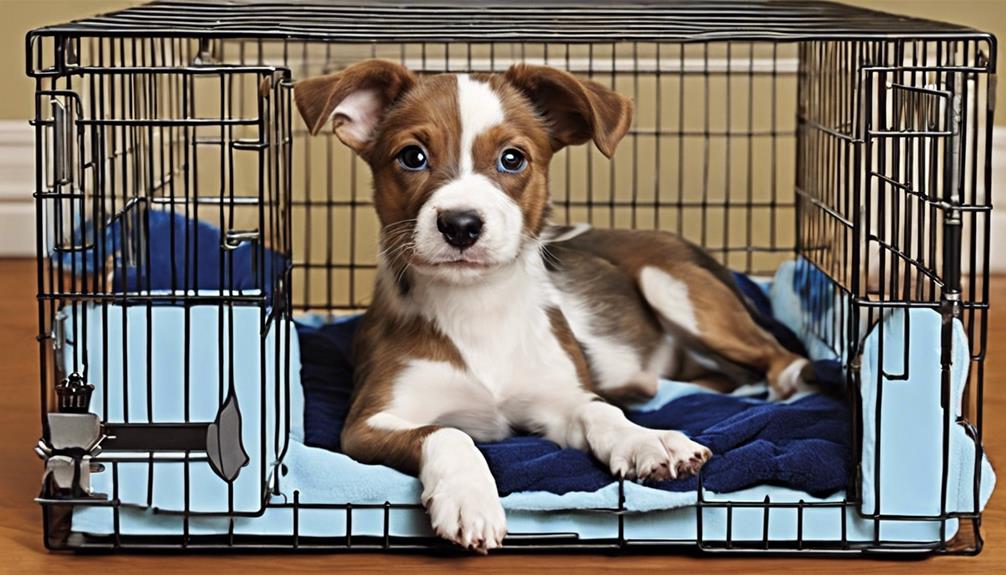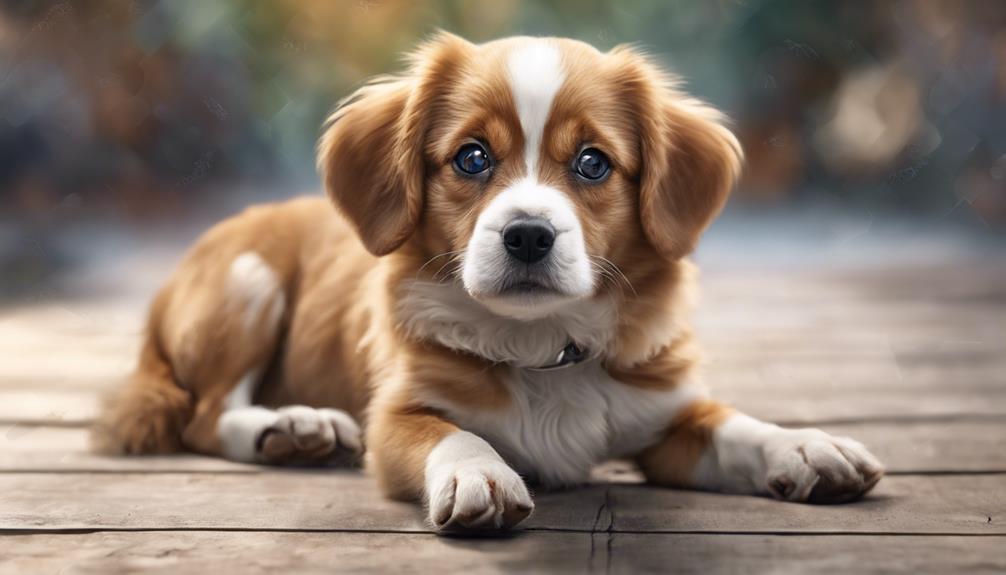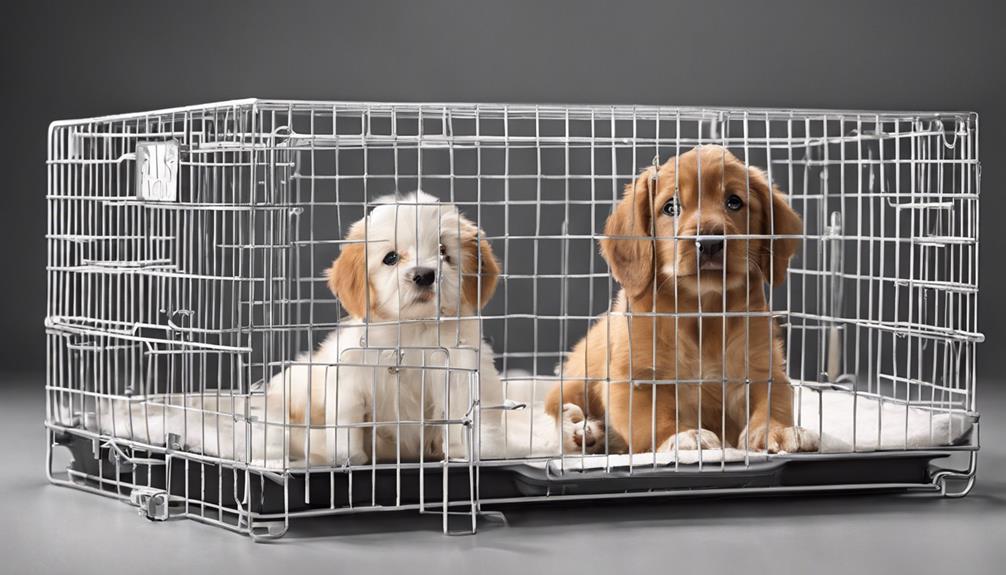When creating the perfect puppy crate training schedule, it is important to have a structured routine that includes potty breaks, meal times, training sessions, and bedtime rituals. Having a consistent schedule will aid in effective housebreaking and crate acclimation, providing a comfortable and secure environment for your puppy. By adhering to a well-planned routine, you can establish a solid foundation for your puppy’s training success.
Key Takeaways
- Establish a structured routine for potty breaks and meals.
- Use positive reinforcement techniques for effective crate training.
- Introduce the crate gradually with comfort and encouragement.
- Set up a peaceful bedtime routine with cozy bedding.
- Incorporate scheduled nighttime potty breaks for young puppies.
Importance of Crate Training for Puppies
Crate training is essential for puppies as it helps them learn bladder control and establish a routine for potty breaks. Introducing your puppy to a crate from an early age provides a vital and important space for them to rest and relax. This training method also plays a critical role in preventing destructive behaviors by giving your puppy a designated area to retreat to when they need some time alone.
Consistent crate training schedules are key in teaching your puppy good behavior. By following a routine, your puppy will quickly learn when it's time to go outside for potty breaks. This not only helps in house training but also strengthens the bond between you and your furry companion. Crate training aids in reducing anxiety by providing a familiar environment for your puppy, helping them adapt to new surroundings with ease.
Choosing the Right Crate Size
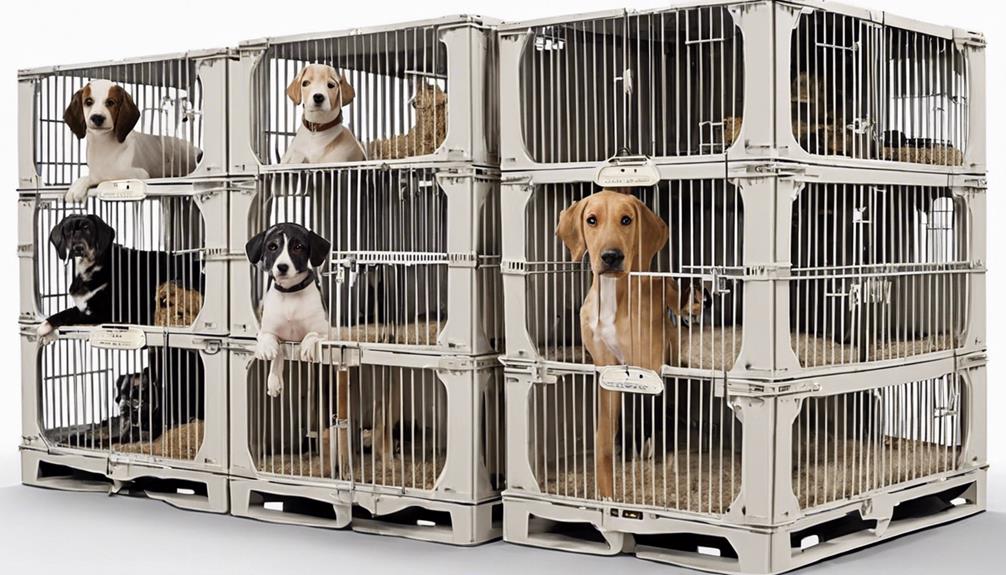
Choosing the suitable size for your puppy's crate is crucial for their comfort and safety. When selecting a crate, make sure it allows your puppy to stand up, turn around, and lie down comfortably.
A crate that's too large may lead to your puppy using one area for elimination and another for sleeping. Proper sizing not only helps prevent accidents but also promotes a sense of security for your puppy.
Take into consideration the adult size of your puppy's breed when choosing the crate size to accommodate their growth. Your puppy's crate should be a cozy and inviting space, not too spacious or cramped, to ensure they feel comfortable and secure.
Teaching Verbal Cues and Hand Signals
When starting crate training with your puppy, make sure to consistently pair verbal cues with hand signals for effective communication. This combination will help your puppy understand your expectations and respond appropriately during the crate training process.
Here are some tips to master teaching verbal cues and hand signals to your puppy:
- Use consistent verbal cues like 'crate time' to introduce your puppy to the crate.
- Pair verbal cues with hand signals, such as pointing to the crate, to reinforce understanding.
- Practice using both verbal and visual commands to guarantee your puppy responds correctly.
- Implement positive reinforcement techniques, like giving treats or praise, when your puppy responds to verbal and hand signals.
Positive Reinforcement Techniques
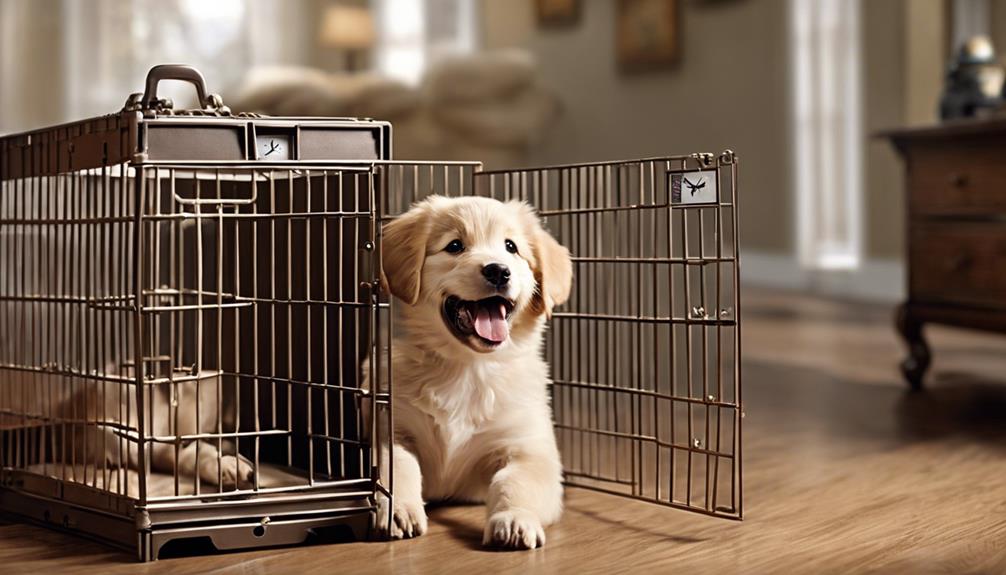
When crate training your puppy, essential reinforcement techniques play a crucial role in encouraging good behavior.
Clicker training benefits by associating the sound with a reward, making it an effective tool for teaching commands.
Treat rewards are also highly effective in reinforcing positive behaviors, making your pup more likely to repeat desired actions.
Clicker Training Benefits
Clicker training enhances dog obedience through the use of a handheld device that emits a distinct clicking sound as a precise marker for desired behaviors. This positive reinforcement technique is highly effective in shaping behaviors and is widely utilized by professional trainers and dog owners.
Here are four benefits of clicker training:
- Precise Communication: The clicker provides a clear and immediate signal to your puppy when they perform the desired behavior.
- Increased Focus: Dogs quickly learn to associate the sound of the clicker with receiving a reward, helping them stay focused during training sessions.
- Fun and Engaging: Clicker training can make learning commands and tricks more enjoyable for your puppy.
- Versatile Training Tool: It can be used to teach a wide range of behaviors, from basic commands to complex tricks, in a structured and effective manner.
Treat Rewards Effectiveness
To effectively reinforce desired behaviors in puppies during crate training, treat rewards serve as a highly impactful tool. Positive reinforcement techniques using high-value treats can help create a positive association with the crate.
When your puppy displays the behavior you desire, reward them with a tasty treat immediately. This positive reinforcement will encourage your puppy to repeat the desired behavior. High-value treats are especially effective in motivating puppies to follow commands and remain calm in the crate.
Structured Routine for Basic Needs

Start by establishing a structured routine that prioritizes meeting your puppy's basic needs before beginning crate training sessions. Here are four essential steps to help you create a successful schedule for your furry friend:
- Regulate Food and Water Intake: Control when your puppy eats and drinks to prevent accidents during crate training. This will also help with housebreaking.
- Plan Around Alone Times: Schedule crate training sessions when your puppy will be unattended. This will aid in their adjustment to being crated during alone periods.
- Incorporate Bathroom Breaks: Make sure your routine includes regular bathroom breaks to prevent accidents and promote good potty habits.
- Adapt for Individual Needs: Customize the schedule to fit your puppy's unique requirements. Be flexible and make adjustments as necessary for effective crate training.
Early Start for Crate Training

When starting your puppy's crate training journey, beginning the process at an early age, ideally around 8-10 weeks old, sets the foundation for successful outcomes. Starting early allows your puppy to adapt to the crate and learn positive associations with it from a young age.
Introduce the crate gradually, making it a vital and inviting space for your furry friend. Use positive reinforcement techniques such as treats and praise to encourage your puppy to enter and stay in the crate willingly. Begin with short training sessions and slowly increase the time spent in the crate to build your puppy's comfort level.
Importance is essential in crate training; stick to a schedule to help your puppy understand when it's time to rest or be alone. By starting early, using positive reinforcement, and maintaining consistency, you can create a positive crate training experience for your puppy, setting them up for success in the long run.
Age Considerations in Training Schedule

Considering your puppy's age is crucial when establishing a training schedule for crate training. Younger puppies have smaller bladder capacities, requiring more frequent bathroom breaks. Here are some age-appropriate schedule considerations to keep in mind:
- Younger Puppies: Puppies aged 8-10 weeks may need to eliminate every 30-60 minutes during the day due to their limited bladder control.
- 11-14 Weeks: At this age, puppies can typically hold their bladder for about 3-4 hours, allowing for longer periods between bathroom breaks.
- 15-16 Weeks: Puppies in this age range can usually hold it for 4-5 hours, indicating increased bladder control as they mature.
- 6 Months and Beyond: By 6 months, most puppies can hold their bladder for 6-7 hours, similar to adult dogs, making it easier to stick to a consistent training schedule.
Keeping these training considerations in mind will help you create an effective and age-appropriate schedule for crate training your puppy.
Creating a Customized Daily Schedule

To effectively tailor your daily routine for crate training, consider your puppy's age and specific needs as the foundation for your customized schedule. When creating a schedule, it's essential to determine the appropriate intervals for crate time based on your puppy's age. Regular potty breaks should be scheduled to prevent accidents in the crate and promote good bathroom habits. Additionally, incorporate playtime and training sessions into the daily routine to keep your puppy engaged and mentally stimulated.
Below is a sample table to help you structure your customized daily schedule for crate training:
| Time | Activity |
|---|---|
| 7:00 am | Potty break |
| 7:30 am | Breakfast |
| 8:00 am | Training session |
| 10:00 am | Potty break |
| 12:00 pm | Lunch |
Introducing the Crate to Your Puppy

Start by allowing your puppy to explore the crate at their own pace to become familiar with it. This step is essential in ensuring that your puppy sees the crate as a comfortable space rather than a place of confinement.
Here are some tips to help you introduce the crate to your puppy effectively:
- Use Positive Reinforcement: Encourage your puppy to enter the crate voluntarily by placing treats or food inside. This will create a positive association with the crate.
- Start Gradually: Introduce the crate in short intervals initially, then gradually increase the time your puppy spends inside. This gradual introduction will help your puppy adjust to being in the crate.
- Make It Comfortable: Add soft bedding or blankets to make the crate a cozy and inviting space for your puppy. A comfortable environment will make your puppy more willing to spend time in the crate.
- Encourage Exploration: Allow your puppy to explore the crate freely without forcing them inside. This will help them feel more comfortable and at ease with their new space.
Nighttime Training and Bedtime Routine

When getting ready for nighttime training with your puppy, make sure the crate is set up with cozy bedding and water.
Take your puppy out for nighttime potty breaks to strengthen good habits.
Establish a peaceful bedtime routine to indicate it's time for rest.
Bedtime Crate Setup
Establish a calming bedtime routine to help your puppy settle in for the night in their crate. Here are some tips to set up your puppy's crate for bedtime:
- Create a soothing environment: Dim the lights and keep noise levels low to encourage relaxation.
- Use a comforting toy: Consider a toy with a heartbeat sound to provide reassurance and comfort for your puppy.
- Avoid nighttime play: Keep interactions during nighttime potty breaks calm to maintain a serene atmosphere.
- Reinforce good behavior: Praise your puppy for successful bathroom breaks outside to support their training progress.
Nighttime Potty Breaks
To guarantee your puppy stays comfortable and learns to associate nighttime with relaxation, incorporating scheduled potty breaks into their bedtime routine is essential. Nighttime potty breaks are vital during crate training to prevent accidents and help establish a consistent puppy schedule.
Remember to close the crate door at night to reinforce the house training routine. For a two-month-old puppy, limit crating at night to a maximum of three hours. Taking your puppy out for a pee break during the night is recommended until they reach four to six months of age.
Initially, ignore any whining in the crate at night to help your puppy associate calmness with rest time. By following these steps, you can effectively manage nighttime potty breaks and guarantee successful crate training.
Quiet Bedtime Routine
Seeking to guarantee a peaceful night for your puppy during crate training? A well-established bedtime routine can make all the difference. Here are some tips to help you create a serene atmosphere for your furry friend:
- Engage in quiet activities before bedtime to promote relaxation and sleep.
- Avoid stimulating interactions or playtime close to bedtime to encourage rest.
- Use calming elements like soothing music or a heartbeat toy to help your puppy settle down.
- Reinforce successful nighttime bathroom breaks with praise to encourage good habits.
Frequently Asked Questions
What Is a Good Crate Training Schedule for Puppies?
To establish a solid crate training schedule for puppies, focus on frequent bathroom breaks, incorporating playtime and meals, short crate sessions, scheduled rest periods, and adapting the routine to meet your puppy's specific needs. Consistency is key for successful training.
How Many Hours a Day Do You Crate Train a Puppy?
You should crate train a puppy for his age in months plus one hour a day. Adjust based on his needs. Stay attentive to comfort and signals. Ignore initial whining. Take him out for breaks as needed.
How Often Should You Let a Puppy Out of a Crate?
You should let a puppy out of the crate every 2-4 hours during the day. The guideline is the puppy's age in months plus one. Younger pups might need more breaks. Overnight, they can hold it for their age in months.
How Long Can You Leave a 8 Week Old Puppy in a Crate?
You can't leave an 8-week-old puppy in a crate for long! Remember, they need potty breaks every 2 hours due to limited bladder control. Avoid anxiety and accidents by following a schedule with short intervals.
Can the Puppy Crate Training Schedule also be used for Potty Training?
Yes, the puppy potty crate training schedule can also be used for potty training. By establishing a consistent routine for crate training, your puppy will learn to control their bladder and bowels, making the transition to potty training easier. Stick to the schedule to see successful results.
Conclusion
Now that you have a structured puppy crate training schedule in place, think of it as your pup's roadmap to success. Just like a compass guides you through unfamiliar terrain, this schedule will guide your puppy towards becoming a well-behaved, happy companion.
Stay consistent and patient, and remember, Rome wasn't built in a day. With time and dedication, your furry friend will learn to love their crate and thrive in their new routine.
